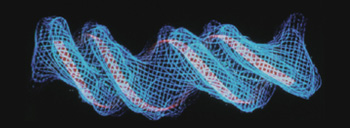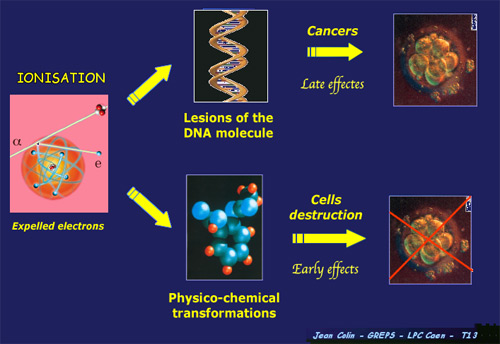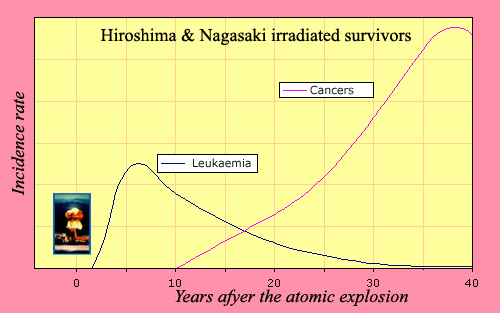Living matter: both fragile and robust

Damage to DNA
Radioactive rays can induce changes in chemical structure which, in turn, can potentially change the cellular structure of living matter. The majority of these changes result from an alteration of DNA – the molecule at the core of the cell which carries the genetic code. There is nevertheless a tiny probability that exposure to radiation can lead to long-term effects such as leukaemia or cancers.
© CNRS
The amount of damage radiation can cause to living matter varies considerably. The ionisation provoked in cells all along the radiation pathway can lead to modifications in the chemical structure of simple molecules such as water as well as the more complex, indispensable molecules of DNA. Our cells are therefore highly vulnerable, but have the capacity to conduct simple repairs in the case of light damage. Living matter proves surprisingly resistant.

From ionisation to biological effects
The most significant biological consequences of radiation result from damages done to DNA molecules. The dissociation of simple molecules such as water – abundant in the human body – liberates highly aggressive ‘free radicals’ into the body. The severity of the effects depends on the density of ionisation in the medium. The more intense and concentrated the energy deposit, the more damaging the radiation can be. However, no hereditary effects (such as the transmission of cancerous genes, for instance) have been observed in humans.
© IN2P3/NEPAL
Living organisms are affected first and foremost on the level of their cells, whose most sensitive element is the nucleus where the DNA is stored. Radiation can weaken a body genetic material by either ripping holes in the DNA structure or changing the chemical bases it uses. The cell can conduct basic repair work on the radioactively-induced damages, which are similar to those caused by chemical or thermal processes. This repair capacity, however, is limited. It can be rendered useless if too much energy is deposited in a cell in too short a time frame. The badly-repaired wounds can then lead to instant or delayed cell death (an inability to undergo cell division) in which case the damage is limited to the cell. It may also lead, in some cases, to mutation which is then transmitted to daughter cells.
At higher intensities, radiation can affect ordinary (somatic) cells or those which play a role in reproduction (also known as seminal cells). In the former case the consequences can lead to the appearance of cancers, while damage inflicted to seminal cells can cause a reduction in fertility or even mutation (though nothing has yet been observed in humans). It is important to remember that not all organs are equally sensitive. Reproductive organs such as the male gonads are more than 20 times as sensitive as skin. Finally, the type of radiation also determines how dangerous the radioactivity can be – as alpha particles are 20 times as toxic as gamma photons for identical energy deposition.

Delayed Effects
Exposure to radiation causes no pain, and the cancers due to radiations often take years to develop. The two curves shown above, based on observations of the atomic bomb victims, reveal that leukaemia and other cancers start to appear well after the initial exposure. It takes up to seven years for leukaemia to reach their maximum, and around forty years for other cancers. These long delays make it almost impossible to attribute an individual cancer to specific radiation.
© IN2P3
Radiotoxicity also depends on an oft-overlooked factor known as radioactive dose rate, which involves dividing the radioactive dose (in grays) by the exposure time. A dose absorbed in a given length of time is more toxic than the same dose absorbed over longer periods. It is almost as though the damage done is so great that the cells ability to repair themselves is swamped and therefore becomes less effective. This factor can be used to our advantage when it comes to targeting malignant tumours. In radiotherapy, very high doses are applied over very localized areas and for very short lengths of time.
NEXT : Probabilistic effects
NEXT : Deterministic effects
Other articles on the subject « Radiation Effects »
Probabilistic effects
The domain of low and average doses For weak or medium-strength doses, the effects are not as cle[...]
Deterministic effects
The domain of strong doses and severe, reproducible effects For high doses above a certain thresh[...]
Dose-effects Relationship
Can effects caused by low doses of radiations be predicted ? Even though we are constantly expose[...]
Dose Rate
Acute and chronic exposures The “effective dose” is not sufficient by itself to chara[...]
Hiroshima Nagasaki Survivors
An exces of cancers and leukaemia among survivors Our knowledge of the risks of cancers due to ra[...]
Low doses effects
Do low doses of radiation have any effect? Radioprotection experts commonly refer to doses below [...]
Linear No-threshold Model
A Precautionary Principle applied to radioactivity … Is it possible to predict the effects [...]
Radioactive Toxicity
A useful indicator but to be used appropriately … The danger presented by a radioactive sub[...]
Dose Factors
What doses when swallowing or inhaling radioactive atoms ? How to evaluate the doses resulting fr[...]